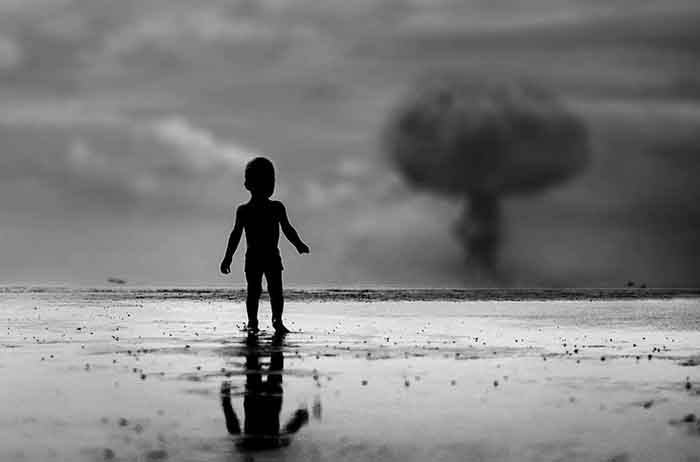by Prof Michel Chossudovsky, Global Research:
 Introductory Note by Michel Chossudovsky
Introductory Note by Michel Chossudovsky
At no point since the first atomic bomb was dropped on Hiroshima on August 6th, 1945, has humanity been closer to the unthinkable – a nuclear holocaust which could potentially spread in terms of radioactive fallout Worldwide .
All the safeguards of the Cold War era, which categorized the nuclear bomb as “a weapon of last resort”, have been scrapped. “Offensive” military actions using nuclear warheads are now described as acts of “self-defense”.
The August 6-8 2003 “Privatization of Nuclear’ War secret meeting was held behind closed doors at Strategic Command Headquarters at the Offutt Air Force Base in Nebraska.
TRUTH LIVES on at https://sgtreport.tv/
It was conducive to a $1.3 trillion dollar nuclear weapons program initiated under the Obama administration, which is slated to increase to 2 trillion dollars by 2030.
Hiroshima Day, August 6, 2024
Towards a World War III Scenario:
The Privatization of Nuclear War
Michel Chossudovsky
August 7, 2011.
Introduction
At no point since the first atomic bomb was dropped on Hiroshima on August 6th, 1945, has humanity been closer to the unthinkable – a nuclear holocaust which could potentially spread in terms of radioactive fallout over a large part of the Middle East.
All the safeguards of the Cold War era, which categorized the nuclear bomb as “a weapon of last resort”, have been scrapped. “Offensive” military actions using nuclear warheads are now described as acts of “self-defense”.
The casualties from the direct effects of blast, radioactivity, and fires resulting from the massive use of nuclear weapons by the superpowers [of the Cold War era] would be so catastrophic that we avoided such a tragedy for the first four decades after the invention of nuclear weapons.1
During the Cold War, the doctrine of Mutually Assured Destruction (MAD) prevailed, namely that the use of nuclear weapons against the Soviet Union would result in “the destruction of both the attacker and the defender”.
In the post Cold war era, US nuclear doctrine was redefined. The dangers of nuclear weapons have been obfuscated.
Tactical nuclear weapons have been upheld as distinct, in terms of their impact, from the strategic thermonuclear bombs of the Cold War era.
Tactical nuclear weapons are identical to the strategic nuclear bombs. The only thing that differentiates these two categories of nuclear bombs are:
1) their delivery system;
2) their explosive yield (measured in mass of trinitrotoluene (TNT), in kilotons or megatons.
The tactical nuclear weapon or low yield mini-nuke is described as a small nuclear bomb, delivered in the same way as the earth penetrating bunker buster bombs.
While the technology is fundamentally different, tactical nuclear weapons, in terms of in-theater delivery systems are comparable to the bombs dropped on Hiroshima and Nagasaki in August 1945.
The Pentagon’s 2001 Nuclear Posture Review envisaged so-called “contingency plans” for an offensive “first strike use” of nuclear weapons, not only against “axis of evil” countries (including Iran and North Korea) but also against Russia and China.2
The adoption of the NPR by the US Congress in late 2002 provided a green light for carrying out the Pentagon’s pre-emptive nuclear war doctrine, both in terms of military planning as well as defense procurement and production. Congress not only rolled back its prohibition on low yield nuclear weapons, it also provided funding “to pursue work on so-called mini-nukes”. The financing was allocated to bunker buster (earth penetrator) tactical nuclear weapons as well as to the development of new nuclear weapons.3
Hiroshima Day 2003: Secret Meeting at Strategic Command Headquarters
On August 6, 2003, on Hiroshima Day, [twenty two years ago] commemorating when the first atomic bomb was dropped on Hiroshima (August 6 1945), a secret meeting was held behind closed doors at Strategic Command Headquarters at the Offutt Air Force Base in Nebraska.
Senior executives from the nuclear industry and the military industrial complex were in attendance. This mingling of defense contractors, scientists and policy-makers was not intended to commemorate Hiroshima.
The meeting was intended to set the stage for the development of a new generation of “smaller”, “safer” and “more usable” nuclear weapons, to be used in the “in-theater nuclear wars” of the 21st Century.
In a cruel irony, the participants to this secret meeting, which excluded members of Congress, arrived on the anniversary of the Hiroshima bombing and departed on the anniversary of the attack on Nagasaki.
More than 150 military contractors, scientists from the weapons labs, and other government officials gathered at the headquarters of the US Strategic Command in Omaha, Nebraska to plot and plan for the possibility of “full-scale nuclear war”, calling for the production of a new generation of nuclear weapons – more “usable” so-called “mini-nukes” and earth penetrating “bunker busters” armed with atomic warheads.4



